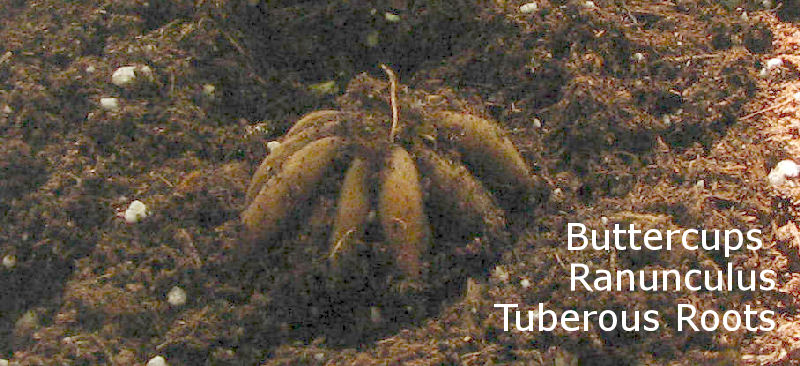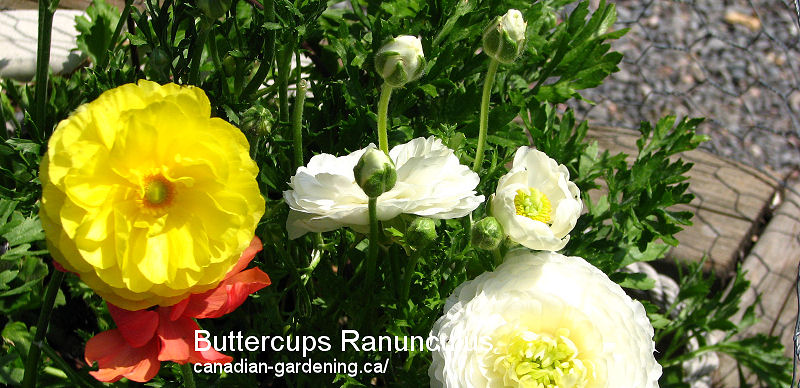How to grow Buttercups Ranunculus in Zone 6
6 Tips for Success

Are Ranunculus a Corm, Bulb or a Tuber?
I had to check this, because this is the Internet.
According to Rodale's Illustrated Encyclopedia of Gardening, Ranunculus is a Tuberous Root - just like a Dahlia.
When you compare a Ranunculus Tuber with a Dahlia Tuber, you can see the similarities.
Discover the secrets to growing vibrant ranunculus flowers in your garden!
From planting tips to care advice, this guide has everything you need to know to get you growing these colourful blooms.
When to plant outdoors?
Plant outside when the danger of frost is over. For me it's at the end of May.
Or start your Ranunculus indoors and plant them outside when it's warm enough. The package suggests starting indoors a month before your last frost date.
Planting Tips for outside:
- Plant in groups of 10 or more . The packages that I bought have 7 in each. They were suppose to have 8.
- Soak your Ranunculus Tubers in cold water for several hours (3-4 hours) before planting them.
- Dig a hole in fertile soil - about 2 inches - 5 cm deep, add compost to hole as well.
- Place the Ranunculus in the hole with pointed side up.
- Space Ranunculus 3 Inches - 7.5 cm apart.
- Cover ranunculus with soil and water thoroughly.
Location:
Full Sun or Semi/Shade
Depth:
2 inch - 5 cm
Distance apart:
3 inch - 7.5 cm
Flowering Period:
July to September
Height:
16 inch - 40 cm
Caring for Ranunculus
I find Ranunculus easy to grow, except the wildlife thought I was growing them a garden. I ended up surrounding the Ranunculus plants with chickenwire. It was not so pretty then. :)
Watering Requirements outside:
Keep the soil consistently moist. Water Ranunculus deeply once a week or more during dry spells.
Fertilizing Ranunculus:
Apply a balanced fertilizer, such as a 10-10-10 formula, in early spring and again after the flowers have bloomed for tuber growth.
Protecting Ranunculus from Pests and Diseases:
Common Pests:
Watch out for pests such as rodents, rabbits, aphids, snails and slugs, which may feed on ranunculus foliage and flowers.
Preventing Diseases:
Ranunculus is susceptible to diseases such as powdery mildew. Ensure good air circulation around plants and avoid overhead watering to prevent fungal infections.
Harvesting Ranunculus Flowers:
Cut ranunculus flowers early in the morning when they are fully open but still cool.
Use sharp scissors to make clean cuts at an angle OR harvest Ranunculus at the soft bud stage and let it open in the vase for longer vase life (10-12 days).
Storing Ranunculus Tuberous Roots:
After the foliage has died back, carefully dig up the bulbs and allow them to dry in a cool, well-ventilated area. Store the roots in a breathable container filled with peat moss or vermiculite until it's time to replant again in the spring.
FAQs (Frequently Asked Questions)
Q:How long do ranunculus flowers bloom?
A: Ranunculus flowers typically bloom for 6-8 weeks.
Q: Do ranunculus flowers come back every year?
A: Ranunculus is a perennial plant in mild climates, but it is often grown as an annual in colder regions. In zone6 it's an annual flower.
Q: Are ranunculus a good cut flower?
A: Yes. It has long sturdy stems and the vase life is about 7 - 10 days.
My Experience with Growing Ranunculus:
Ranunculus Outdoor Planting (my favourite):
I began by planting my ranunculus roots directly in the garden.
Covered the roots with chickenwire as a rodent deterrent.
After watering them thoroughly, I patiently awaited for them to sprouts, providing additional water as necessary.
Being careful to not overwater.
Ranunculus Indoor Cultivation:
I attempted to start ranunculus indoors under grow lights. Despite watering the soil only before planting, I observed the emergence of grey mold on the soil surface. Upon inspecting the roots, I discovered that all my ranunculus plants had become moldy. I was so disappointed! Another year lost!
Analysis of the Issue:
I suspect that the indoor soil retained excessive moisture, creating an environment conductive to mold growth. Ranunculus are prone to rot if overwatered or if the soil lacks proper drainage.
I only watered once and I had proper drainage in the pot. Maybe the soil need to be amended with perlite for extra drainage ?
So, I bought more Ranunculus and started again.
This time I soaked the tubers until they were hydrated ( some people leave them in water for 3-4 hours ).
Moisten the soil until it was wet by not saturated and just pushed the tubers in the moist soil, dusted the ranunculus with soil and put them under grow lights and waited.
Removed any tubers that were starting to rot and plant them in another pot, just in case they still wanted to grow. :)
Ranunculus started growing surface roots - spidery type roots on the surface of the soil. At first I didn't know what they were, until I started pulling on them. :)
Ten days later I started to see sprouts and now my Ranunculus are ready to be planted out.
Do I think these flowers are worth all of the fuss?
If you are bored and want a different plant in your garden to learn and admire? Yes! :)
Future Approach:
Given this experience, I am inclined to continue with outdoor planting. This method conserves indoor space and primarily only requires vigilance against rodents that might target the tubers. So, I cover tubers with chickenwire after planting.
I've learned that while indoor cultivation of ranunculus offers control over environmental factors, it also requires meticulous attention to moisture levels to prevent mold.
If you are a flower farmer - starting ranunculus indoors will help getting early flowering stems.
While outdoor planting, though subject to external variables, have proven to be more successful for me, provided I protect the roots from pests.
I will did up my ranunculus this fall and plant them in the spring again, but I'm not buying anymore tubers. :)
Pretty flowers, just too fussy for me at the moment.
Bulbs, Tubers and Corms || All about Flowers
